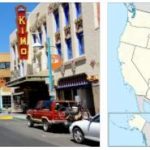Geology. – A country of mountains and high plateaus (4/5 of the territory are located at more than 1000 m asl), Mexico is constituted by the continuation of the western cordillera of North America. The salient features of the relief are first of all in the Central Plateau, bordered by the Western Sierra Madre and the Eastern Sierra Madre ; in a volcanic chain that delimits the plateau to the S; in a mighty southern mountainous region. The plateau proper (mesa) reaches 2400 m SE of Puebla, with decreasing altitudes towards N and towards E. Consisting of a crystalline and metamorphic base on which a thick succession of marine sediments from the Mesozoic rests, it rose from the end of the Cretaceous; from wrinkles and fractures the magma that often covers the Mesozoic deposits escaped. Between the US border and latitude 22 ° N, the plateau is arid or semi-arid; limestone mounds and reliefs are separated by thick eluvial deposits that fill closed basins with no flow to the sea, the typical bolsones, including the vast Bolsón de Mapimí. AS, the plateau is higher and wetter, covered with volcanic deposits, and features numerous volcanic buildings. The Eastern Sierra Madre is a large folded range whose crests even exceed 3000 m (Peña Nevada, 3644 m); the Sierra Madre Occidentale has the appearance of a stocky and massive relief, consisting of thick basalt flows whose summit parts often exceed 3000 m (Mohinora, 3992 m). The slopes that descend towards the interior, where vast intermontane basins open, are gentle.
AS of these two submeridian bastions and the mesa, the neo-volcanic axis, one of the most imposing volcanic ensembles in the world, extends for about 1000 km, from the Pacific (Cape Corrientes) to the Gulf of Mexico (Tuxtla group). The buildings, active or dormant or inactive, present the most varied forms of the volcanic repertoire, and in most cases exceed 4000 and 5000 m in height (Nevado de Colima, Nevado de Toluca, Ixtacíhuatl, Popocatepetl, Pico de Orizaba). At the southern foot of this alignment there is a long and wide depression (graben) crossed by the Río Santo Domingo, which flows into the Gulf of Campeche, to the East, and from the Río Balsas, which pays tribute to the Pacific to the W. Between the Eastern Sierra Madre and the Gulf of Mexico the Texas plain continues: 300 km wide in Tamaulipas, it narrows between Tuxpan and Veracruz, then widens by new up to Yucatán; alluvial along the coastal margin, with marshy areas and lagoons, is made up of tertiary sediments and contains rich oil deposits. On the Pacific, from the planes of the Sonoran Desert (continuation of the Colorado and Gila deserts) and of the State of Sinaloa, the plain narrows towards the S, where the sea reaches the buttresses of the mountains and there are high and rocky coasts with splendid inlets: Puerto Angel, Acapulco, Manzanillo, Puerto Vallarta. For Mexico 1999, please check estatelearning.com.
South of the Río Balsas relief is composed of the systems of Guerrero and ‘ Oaxaca, O, and from the mountains of Chiapas, E. These highlands in the first section are called Sierra Madre del Sur and go up to 3700 m. AS of the isthmus, the reliefs regain vigor with the Sierra Madre of Chiapas. Also in this stretch, on the Pacific coast, the plains are very narrow, while on the Gulf of Mexico there are extensive alluvial plains, with low and marshy coasts. The Yucatán peninsula has a low coastline, which disappears under a veil of shallow marine waters, forming the very extensive platform of the Banco de Campeche. The peninsula is a low-lying limestone plateau with widespread karst phenomena. Finally, to the NW, the long and thin peninsula of Baja California is a plateau (over 3000 m asl) of granite rocks sometimes covered by lava which, in the middle section, extends for about 800 km in a decidedly desert environment.
Mexico (among the most unstable lands in the globe) is affected by earthquakes and volcanic activity, particularly in the bottom of the Gulf of California and on the southern Pacific coast, from the State of Nayarit to Chiapas.
HYDROGRAPHY. – The sierras and the volcanic chain that cuts them in an S enclose the plateau and prevent the outflow of its waters to the sea, while relatively short and precipitous rivers flow on the external slopes. The water regime sees the maximum flows – sometimes due to devastating floods – during the hot season, coinciding with the rainy period. Maximum river of Mexico is the Río Bravo del Norte, which flows into the Gulf of Mexico; it has large flows and in summer it is subject to floods. Numerous centers have sprung up on its bank, which in many cases correspond to twin centers on the opposite side: thus the Mexican Ciudad Juárez faces the American El Paso, the American Laredo in Nuevo Laredo, the American Brownsville in Matamoros, etc.
Among the rivers that flow from the Western Sierra Madre to the Pacific, the largest are the Río Sonora, the Río Yaqui, the Río del Fuerte, the Río Grande de Santiago, one of the longest in the country, and the Río Balsas, characterized by deep gorges, cataracts, rapids and waterfalls, and by frequent setbacks of the valley heads that have caused capture phenomena. The watercourses of the external slope of the Eastern Sierra Madre behave similarly: among them the Río Pánuco, the Río Tecolutla, celebrated for its imposing waterfall, the Papaloapan, with its outlet in the Alvarado Lagoon, the Río Grijalva and Usumacinta, which form a common delta. The hydrography of the plateau is mostly landlocked and the waters pour into depressions where often brackish lakes or lagoons lie.









